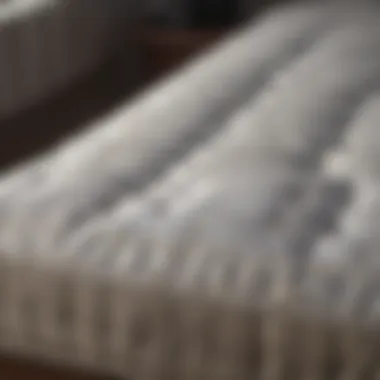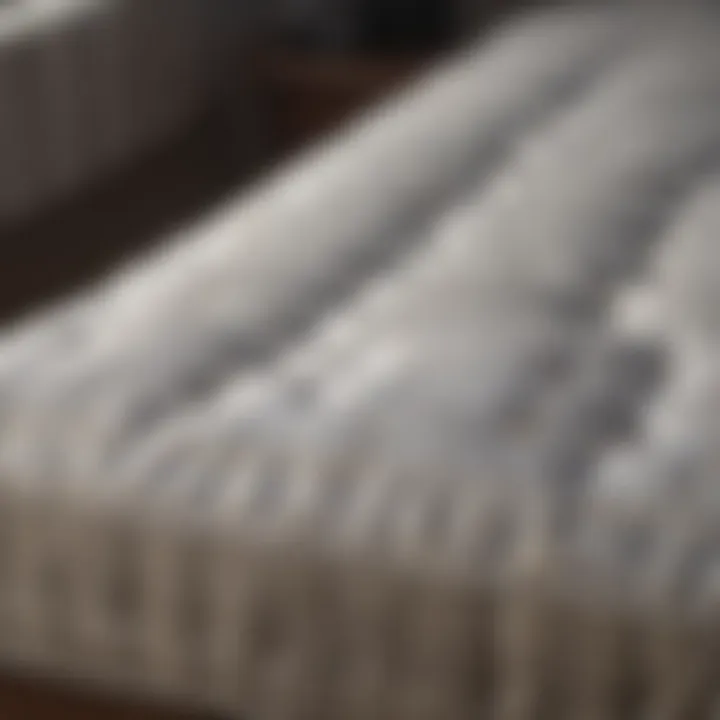Enhance Your Sleep: Benefits of Flipping Your Mattress


Intro
When it comes to creating a serene sleeping environment, many people focus on the mattress itself—choosing the right material, firmness, and size. However, one crucial aspect often falls by the wayside: the act of flipping or rotating your mattress. It might seem like a small, almost mundane task, but the benefits are significant and multi-faceted. By regularly flipping your mattress, you can enhance not only your comfort but also the longevity of your mattress itself. Everybody loves a good night’s sleep, but hardly anyone talks about the mechanics behind it.
In this exploration, we will dissect the importance of flipping your mattress, explore how it affects the quality of sleep, and delve into some practical tips for maintaining this essential piece of furniture.
Design Inspiration
Trending Styles
A well-cared-for mattress enhances not just your sleep but can also complement your bedroom’s decor. While the interior aesthetic varies from minimalist to bohemian, consider choosing a mattress that meshes well with your style without compromising comfort. Brands like Tempur-Pedic or Saatva offer timeless options that sit well on any frame, while also providing substantial support. Your mattress is not just a functional object, it can resonate with the mood of your bedroom.
Color Palettes
While the color of a mattress probably isn’t what you first think of, the bed frame and surrounding textiles can accentuate your sleeping quarters. Calming hues such as soft blues or gentle greens can create a soothing atmosphere. After all, the goal is to craft a retreat—a space where you can wind down and relax, contributing to better overall sleep quality.
Practical Tips
Maintenance & Care
To keep your mattress in tip-top shape, flipping it consistently is the best practice to mitigate uneven wear. Ideally, you should flip your mattress every three to six months. Alongside flipping, maintain the mattress by vacuuming it to remove dust and debris—this also helps stave off allergens that could disrupt sleep. Newer mattresses often come with specific care instructions, so always check the guidelines provided by the manufacturer.
Budgeting & Planning
Though it may sound trivial, budgeting for a good mattress and its upkeep can save considerable costs down the line. Rather than opting for the cheapest option, invest in a quality mattress that will stand the test of time. Additionally, consider setting aside a small portion of your budget for accessories like mattress protectors, which can prolong the life of your mattress significantly while adding an extra layer of comfort.
Regularly flipping your mattress can reduce wear and improve the lifespan, ensuring your investment is maximized over the years.
In summary, prioritizing mattress care not only enhances comfort but also feeds into the larger picture of creating a restorative living environment. Flipping your mattress isn’t merely maintenance; it’s an investment in your overall quality of sleep and well-being.
Understanding Mattress Structuring
Understanding mattress structuring is crucial for homeowners and design enthusiasts alike when it comes to elevating sleep quality and ensuring longevity of this essential item. A mattress isn’t just a flat surface to lie down on; it’s a complex assembly of various materials and components designed to provide specific benefits. Knowing how these elements work together can pave the way for better care practices, such as regular flipping. In this section, we will dissect what goes into a mattress, how materials affect durability, and the significance of layers in offering support.
Components of a Mattress
A mattress is made up of several key components that contribute to its overall feel and functionality. Let’s take a look at these elements:
- Core Material: This is the heart of the mattress, often made from innerspring coils, foam, or latex. Each type has its unique feel and level of firmness.
- Comfort Layers: These layers sit atop the core and provide the initial feel when you lie down. They can be crafted from memory foam, latex, or polyfoam, influencing softness and breathability.
- Cover Fabric: The outer layer made from various materials that can be breathable, soft, or hypoallergenic, further affecting your sleeping experience.
- Edge Support: Many mattresses include reinforced edges, which can help in maintaining shape and providing extra seating space.
Understanding these components can help you appreciate the necessity of flipping your mattress. It can distribute weight more evenly, preventing some areas from sagging more than others.
How Different Materials Affect Durability
When considering durability in a mattress, the materials used are vital. Let’s break down how the different options stand the test of time:
- Innerspring: Generally, these mattresses can last around 5 to 10 years, depending on coil gauge and construction quality.
- Memory Foam: High-density foams can last longer, approximately 8 to 15 years, if properly cared for and not subjected to extreme wear.
- Latex: Known to be one of the longest-lasting materials, latex mattresses can hold up to 15 years or more, benefiting from natural elasticity and resiliency.
Choosing a durable material encourages an informed flipping routine; doing so can help soften the initial wear and align with the lifespan of the material.
The Role of Layers in Support
Layers in a mattress do not just add plushness but play an essential part in providing support and alignment. Here’s how:
- Support Layers: Usually made of high-density foam or latex, these create a foundation that keeps your spine aligned. They adapt to your body shape without compromising support.
- Transitional Layers: These layers help bridge the gap between comfort and support layers, which eases body pressure points and can drastically improve sleep comfort.
- Surface Layer: The top surface can influence how well you sink into the mattress, affecting overall body support.
To sum up, understanding mattress structuring equips you to grasp the benefits of flipping. It does not just extend your mattress life; it also enhances your sleep experience, making it worthwhile to invest time into this simple act.


"Regular maintenance not only ensures optimal comfort but can also safeguard the investment made into your mattress."
This groundwork leads us nicely into understanding the significant reasons for flipping your mattress.
The Importance of Flipping Your Mattress
Flipping your mattress might not seem like a big deal, but its importance should not be dismissed out of hand. Many people underestimate how this simple act can contribute to overall comfort and longevity of their sleeping surface. Firstly, let's dive into the various benefits that come along with flipping a mattress.
Preventing Uneven Wear
One of the biggest culprits of a mattress losing its shape and comfort over time is uneven wear. When you sleep consistently on one side or one spot, you may inadvertently form dips and indentations that lead to discomfort. This unevenness not only disrupts your sleep but can also create pressure points that lead to aches and pains upon waking. Consider this: if you always sit in the same spot on your couch, it won't take long before that area starts to look different than the rest. The same principle applies to your mattress. Therefore, flipping your mattress regularly can help promote even wear, enabling each layer to rest and recover over time.
Tips to Prevent Uneven Wear:
- Rotate your mattress: Along with flipping, rotate it 180 degrees every few months to ensure every part gets equal use.
- Sleep in different positions: If possible, change your sleeping position to evenly distribute your weight across the mattress.
- Use a mattress protector: This not only shields from stains but also adds an extra barrier of support.
Enhancing Sleep Quality
With a flip, you might find that your sleep quality significantly improves. Many mattresses, particularly those with memory foam or pillow-top features, tend to conform to your body shape over time. This may feel comfortable initially, but it can lead to poor spinal alignment if not maintained properly. Flipping the mattress offers a fresh surface to lay down on, which can alleviate discomfort and stiffness. Think about it this way: sometimes, simply moving to a different seat can make you feel much better, as if the pull of your sedentary position fades away.
Enhance Sleep with These Practices:
- Establish a Routine: Pair flipping the mattress with your regular cleaning day to create a routine that promotes better quality sleep.
- Monitor Your Sleep Quality: Use a sleep tracker app to identify patterns and see if flipping correlates with improved restfulness.
- Consider Timing: Flipping right before a long sleep stretch, like weekends, can maximize its benefits.
Maintaining Structural Integrity
Lastly, maintaining the structural integrity of your mattress is crucial. Flipping enables the materials within the mattress to regain shape and composure. Over time, mattresses can sag or warp, which leads to reduced support. Especially with inner spring mattresses, flipping can prevent coil breakdown and maintain proper support for your spine and body. Keeping the foundation of your mattress in good working order ensures you wake up feeling rejuvenated rather than stiff.
Ways to Maintain Structural Integrity:
- Regular Inspection: Check for any signs of wear or tears in the fabric and deal with them immediately.
- Follow Manufacturer Guidelines: What might seem unnecessary might actually be crucial as per the manufacturer's instructions.
- Use a Solid Foundation: Placing your mattress on a sturdy base or adjustable bed frame can further promote long-term stability.
In summary, flipping your mattress is not just a chore - it's an essential maintenance practice that prevents uneven wear, enhances sleep quality, and maintains structural integrity. Keeping these elements in check allows you to create a restful sleeping haven that contributes to overall well-being.
Assessing the Right Time to Flip
Understanding when to flip your mattress is crucial in maintaining its longevity and ensuring a restful night’s sleep. Many people don’t think about this until they start noticing signs of wear and tear. An informed approach can make all the difference, enhancing comfort, reducing physical strain, and ultimately extending the lifespan of your mattress.
Indicators of Mattress Wear
There are several indicators that strongly suggest it might be time to flip your mattress. Here are some common signs to watch for:
- Sagging: If you notice noticeable dips or sags in the mattress, it is a clear sign that the support structure is failing. This usually happens more often in one spot where you sleep.
- Lumps or Bumps: A lumpy surface can disrupt sleep quality and may indicate that the materials inside are breaking down. You should be able to feel if there are inconsistencies on the surface of your mattress.
- Allergic Reactions: If you begin experiencing allergies or respiratory issues, it could be a sign of dust mites or mold accumulating in your mattress. Regular flipping can help reduce these problems.
- Uneven Pressure: If you find yourself waking up with aches and pains in specific areas of your body, it may be time to flip. This can help equalize pressure distribution while you sleep.
Manufacturer Recommendations
Many mattress manufacturers offer guidelines on how often you should flip your mattress. Generally, they recommend flipping it at least every three months. However, different types of mattresses might require different care:
- Innerspring Mattresses: These usually benefit from regular flipping due to their construction. Each side can provide support.
- Foam Mattresses: Some manufacturers advise against flipping these types as they are designed with a specific side for sleeping. Instead, rotating these mattresses might be the better option.
- Hybrid Mattresses: These often combine innerspring and foam. Flipping them can help balance out wear but should be checked against the manufacturer’s suggestions.
"Flipping is not just good for the mattress; it’s good for your health and sleep comfort as well."
Be sure to always check your warranty and specific recommendations that accompany your mattress purchase. Knowing and following these guidelines can help ensure that you’re not voiding any contracts with manufacturers.
Personal Sleep Patterns and Their Influence
Understanding your own sleep habits is just as essential when deciding on the right time to flip your mattress. Here are a few considerations:
- Sleep Position: If you predominantly sleep on one side, particularly if you’re a back or stomach sleeper, flipping can balance out wear in the mattress. This can also help provide more uniform support.
- Change in Weight: If you or your partner experiences significant weight changes, flipping can help cover the areas of the mattress that experience more pressure, thus prolonging its life.
- Frequency of Use: If you find that your mattress is subjected to frequent use — perhaps you host guests often or have children jumping on it — more frequent flipping may be necessary to keep it from wearing unevenly.


Regularly assessing these factors will not only keep your mattress in prime condition but also ensure that you’re always getting the restful sleep you need. Keeping an eye on wear patterns, sticking to manufacturer’s guidelines, and thinking about your own personal sleep habits are all pivotal in determining the right moment to flip.
How to Properly Flip Your Mattress
Flipping a mattress is more than just a chore; it’s a practice vital to maintaining the integrity and comfort of one’s sleep surface. This section will delve into how to effectively flip your mattress, ensuring you reap the full benefits of this simple yet impactful task. Understanding the correct procedures and methods not only prolongs the life of the mattress but also enhances the quality of your sleep, making it an essential part of home maintenance.
Preparation Steps Before Flipping
Before you embark on the journey of flipping your mattress, certain steps are essential for a seamless process. Here are the preparation steps to follow:
- Clear the Area: Ensure the surrounding area of the bed is tidy. Any clutter could become an obstacle when flipping the mattress, potentially leading to mishaps.
- Remove Bedding: Strip the mattress of all bedding. This includes sheets, blankets, and any mattress protectors. Not only does this lighten the load, but it also provides an opportunity to sanitize the linens.
- Inspect the Mattress: Before flipping it, take a good look at the mattress for any signs of damage or wear. If there are rips or sagging areas, it may impact how you flip or support it.
- Identify the Flipping Method: Determine whether your mattress allows for flipping. Many modern mattresses are single-sided, but double-sided ones can be flipped routinely. Knowing your mattress type clarifies what method to use.
- Gather Support: It might be wise to enlist a helper for this task, especially if your mattress is heavier. Two pairs of hands can make a big difference, ensuring safety and ease during the flipping process.
Techniques for Flipping
When it’s time to actually flip your mattress, using the right techniques is crucial. Here are steps to do it correctly:
- Positioning: Stand at the side of the bed, deciding if you want to flip it end-to-end or side-to-side. Each method has its purpose depending on the mattress construction.
- Lift and Roll: Start by lifting one end of the mattress while your helper holds the other side. It’s often easier to roll it onto its side. This minimizes strain on your back and allows for a controlled flip.
- Complete the Flip: Once the mattress is vertical, rotate it so the opposite side is facing up. Move it carefully to the original position. Remember to maintain a firm grip to avoid dropping it.
- Adjust Position: After flipping, gently shake the mattress back and forth to ensure it settles correctly. This helps maintain its shape and support.
Using Additional Support Tools
To maximize the effectiveness of flipping your mattress, consider utilizing additional tools:
- Mattress Lifter: This handy tool can help prop the mattress up at an angle, making the process easier and safer. It’s especially useful for heavier mattresses, taking weight off your back.
- Furniture Sliders: If your mattress is particularly heavy or you have difficult flooring, sliders can drastically reduce friction. They allow you to move your mattress with minimal effort, making the flip more manageable.
- Grip Gloves: Wearing gloves can enhance your grip, reducing the chance of slips while lifting and flipping the mattress.
"A little preparation goes a long way. It’s not just about flipping the mattress; it's about ensuring a sustainable and comfortable sleeping environment."
These steps and tools, while seemingly small, make a significant difference in the effectiveness and ease of flipping a mattress. Taking the time to prepare and equip yourself properly may lead to longer-lasting comfort and enhanced sleep quality.
Maintaining Your Mattress Post-Flip
Taking care of your mattress after flipping it is like giving it a well-deserved spa day. Just like humans, mattresses need maintenance to keep their performance consistent and their longevity intact. It’s not just about turning the thing over; it’s about a whole regimen that ensures better comfort and durability. You wouldn’t ignore your car’s oil changes, and your mattress deserves the same level of attention.
In this section, we’ll explore the importance of cleaning and care, monitoring the condition, and the role of mattress protectors in maintaining your mattress post-flip.
Cleaning and Care Guidelines
Cleaning a mattress might not be your idea of a fun Saturday, but it’s a relatively straightforward task that goes a long way in keeping your sleep sanctuary fresh. Here’s how to go about it:
- Vacuum Regularly: A good vacuum can suck up dust, dirt, and whatnot. Do this lightly, using a brush attachment to avoid damaging the surface.
- Spot Clean Stains: Accidents happen. For spills or stains, use a mild detergent or a specialized mattress cleaner. Blot the area instead of scrubbing to preserve the fabric.
- Flip and Rotate: After a few weeks of flipping, it’s wise to rotate your mattress. This helps in evenly distributing the wear and keeps the comfort consistent.
With consistent cleaning, you not only enhance the look but also extend the life of your mattress.
Monitoring Mattress Condition
Here’s a little secret: keeping an eye on your mattress condition can save you from backaches in the long run. A sagging or deformed mattress is like driving an old banger—it’s not going to support you the way it should.
- Check for Uneven Wear: After you flip the mattress, pay close attention. Look for dips or lumps. These can affect your sleep quality and signify that it’s time for a change.
- Inspect for Odors: An unpleasant smell doesn’t just magically disappear. It usually means that it is harboring bacteria or mold, which is no good. If it smells musty after cleaning, consider using a mattress-specific air freshener or baking soda for odor control.
By keeping an eye on these conditions, you not only ensure better sleep but also promote health in your resting environment.
The Role of Mattress Protectors
A mattress protector is like an insurance policy for your bed. It might seem like an unnecessary expense at first, but in the long run, it pays dividends in comfort and cleanliness.
- Stain Resistance: A decent mattress protector will repel spills and stains, making the cleaning process much simpler. Imagine a glass of water toppling over; with a protector, it’s just a quick wipe.
- Dust Mite Barrier: If allergies are your foe, a quality protector can be a game-changer. It acts as a barrier against dust mites, keeping your mattress cleaner and healthier.
- Temperature Regulation: Some protectors even help in temperature regulation, providing a comfortably cool surface during hot summer nights.
Ultimately, investing in a good protector can greatly enhance your mattress’s lifespan and maintain its supportive qualities.
Taking time to properly maintain your mattress post-flip contributes significantly to your overall health and quality of sleep. Investing a few moments here can yield impressive dividends down the line.


Common Myths About Mattress Flipping
When it comes to mattress care, flipping is often clouded by a haze of myths and misconceptions. This section sheds light on the common myths that misguide homeowners and sleep enthusiasts alike. Debunking these falsehoods is crucial; it not only enhances awareness but also encourages better sleep practices and overall mattress longevity.
Debunking Misconceptions
One of the most common misconceptions is that all mattresses can be flipped; however, this simply isn’t the case. Many modern mattresses—such as memory foam and hybrid options—are designed with a specific top and bottom. Flipping these types can cause significant discomfort or damage, leading some to throw out the idea of flipping altogether, even for suitable mattresses.
It's essential to understand that while not every mattress is meant to be flipped, those that are typically have a sturdier design that supports this maintenance practice. This leads us to another point: the belief that flipping a mattress will restore its original feel. While flipping can redistribute wear and tear, it won’t alter the inner workings if the mattress is on its last legs. Regular flipping, nonetheless, plays a part in prolonging the life of a properly designed mattress, ensuring even wear over time.
Understanding Mattress Technology Advances
With the evolution of sleep technology, mattress designs have changed significantly. Gone are the days of simple spring mattresses that could easily be flipped. Today, we have materials designed to enhance comfort, support, and overall sleep quality.
For instance, a high-quality memory foam mattress adapts to the shape of the body, providing targeted support but loses that ability if flipped. Similarly, innovations like gel-infused foam and pocket coil technology create specific sleeping experiences that cater to diverse needs. Therefore, homeowners must assess their mattress technology. It is vital to check the manufacturer’s guidelines that elaborate on flipping and care because this goes a long way in extending lifespan and comfort.
Popular Misunderstandings in Sleep Science
Lastly, there are several misconceptions floating around regarding sleep science itself and its relationship with mattress flipping. One widely believed theory is that older mattresses, regardless of types, need only to be flipped to remain optimal. The reality is a bit more complex—age and material play pivotal roles.
As mattresses age, even with the best care and flipping routines, they undergo wear that can't be reversed merely by flipping. It’s crucial to listen to your body and monitor your sleep quality. If you wake up with pains or feel unrested, it might be time to consider a replacement, irrespective of how many times you’ve flipped it. Regular maintenance, including flipping and cleaning, is only part of ensuring a truly restorative sleep environment.
In summary, understanding the myths surrounding mattress flipping fosters informed decisions, ultimately resulting in better sleep quality and mattress longevity.
In closing, breaking down these misconceptions is essential for homeowners and sleep enthusiasts. By learning what is true and what isn’t, one can better navigate the complexities of mattress care and improve their overall sleep experience.
Long-Term Benefits of Regular Flipping
Flipping your mattress isn’t just a good deed for that one time; it's a habit that can bring a host of long-term advantages. A mattress isn’t designed to be a one-trick pony; it requires regular attention if you want to get the most out of it. Let’s dig deeper into the long-term benefits, showcasing how consistent flipping can have a far-reaching positive impact on your sleep lifestyle.
Increased Lifespan of Mattress
One of the most significant aspects of flipping your mattress is the extension of its lifespan. You see, mattresses are like fine wine. They age better with care and attention. When sleeping on one side consistently, you create indentations and uneven wear, which ultimately leads to faster degradation. Conversely, flipping it promotes even weight distribution.
This practice can add years to the life of your mattress. Think about it: a decent mattress isn’t exactly pocket change, so why not nurse it to last as long as possible? By flipping it, you stave off those unpleasant dips that signal it’s time to toss it in the trash.
"A little effort in flipping today can save you a new mattress tomorrow."
Enhanced Comfort Over Time
Let's not forget about comfort. Over time, every mattress undergoes some degree of wear. Flipping can help mitigate the sagging and loss of support that can develop after months or years of slumber. When you alternate sides, you reinvigorate the comfort layers, making the sleeping experience feel fresh again.
Imagine laying down on a mattress that feels as good as new, not just the same comfortable surface you’ve come accustomed to. You’ll likely notice improved back support, less pressure on your joints, and a more supportive sleep environment. Consistent flipping can transform your nightly rest from an ordinary experience to something extraordinary.
Financial Implications of Proper Care
Lastly, let's talk finances—because, let's be real, money matters. Investing in a good mattress can be quite the financial commitment. However, neglecting its care can lead to premature replacement, which is a real wallet drain. By making flipping a part of your maintenance routine, you can avoid invest more in mattresses. Regular flipping not only elongates the life but also maintains the mattress's structural integrity, meaning you get to sidestep that costly trip to the store for a new bed sooner than you’d like. Plus, reducing the chances of needing a replacement means you can use those funds for something else—be it a fancy dinner or that long-desired vacation.
Closure and Final Considerations
Flipping your mattress may seem like a small task in the grand scheme of your home maintenance routine, but its importance can't be overstated. This final section encapsulates the essence of why such a seemingly mundane act carries so many benefits. The process of flipping your mattress is not merely about prolonging the life of the bed. It plays a critical role in enhancing sleep quality, ensuring consistent support, and maintaining the overall structure of the mattress as it ages.
One crucial aspect discussed in this article is the prevention of uneven wear. Over time, your mattress conforms to your sleeping patterns, leading to sagging or indentations. By flipping it regularly, you allow the materials to reset, which helps maintain an even surface for sleep. This small change can have a dramatic impact on your quality of sleep and subsequent daily energy levels.
Moreover, the benefits are long-term. As we’ve learned, healthier sleep contributes not only to physical well-being but also to mental sharpness and emotional stability. A mattress in good condition can be a game changer when it comes to waking up refreshed, ready to tackle whatever life throws your way.
Additionally, while flipping your mattress is essential, it should be accompanied by a holistic approach to mattress care. Maintaining a clean sleeping environment, investing in a good mattress protector, and adhering to proper cleaning routines will further enhance the life of your mattress. These aren't just tasks; they’re small acts of care that accumulate into a more restful sleeping environment.
In a world filled with distractions and busy lifestyles, prioritizing regular mattress maintenance isn't just smart; it's necessary. With the right approach, your mattress can be a sanctuary for rejuvenation, well into the future.
Summary of Key Points
- Flipping your mattress regularly prevents uneven wear and extends its lifespan.
- Improved sleep quality directly correlates with health benefits including increased energy and improved focus.
- A holistic care routine, including clean linens and mattress protectors, will enhance comfort and ensure your investment lasts.
- Being proactive about mattress maintenance makes a tangible difference in your daily life.
Encouragement for Regular Maintenance Routines
Creating a schedule for mattress care can be particularly effective. For instance, consider flipping your mattress every six months. Pair this with seasonal deep cleaning of your bedding, and you’ll have a maintenance routine in place that promotes a consistently restorative environment.
Being proactive rather than reactive in mattress care leads to a healthier sleep environment. The time and effort spent on this routine will echo in the quality of your rest and your overall daily wellbeing. Make it a habit, and soon it will be second nature, leading to sleeping like a baby for years to come.















